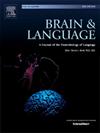Neural associations between fingerspelling, print, and signs: An ERP priming study with deaf readers
IF 2.3
2区 心理学
Q1 AUDIOLOGY & SPEECH-LANGUAGE PATHOLOGY
引用次数: 0
Abstract
Fingerspelling is a leading predictor of reading ability for deaf people who use a signed language, but few neuroimaging studies have examined how it supports reading. We used event-related potentials to investigate how fingerspelled words prime printed words. Twenty-four skilled deaf adult readers completed a Go/No-Go task while viewing printed English word targets following related and unrelated primes in one of three conditions: printed English words, American Sign Language (ASL) signs, and fingerspelled words. N400 priming effects were strong across all three conditions. Early N400 effects were similar for printed word primes and fingerspelled word primes, suggesting shared orthographic representations. Late N400 effects were strongest for printed word primes, reflecting less effortful processing when primes and targets were in the same printed modality. These findings provide evidence for cross-language and cross-modal priming between fingerspelled and printed words and underscore the importance of fingerspelling in developing word representations for skilled reading.
手印、手印和手语之间的神经联系:对失聪读者的ERP启动研究
手指拼写是使用手语的聋人阅读能力的主要预测指标,但很少有神经影像学研究调查它是如何支持阅读的。我们使用事件相关电位来研究手指拼写单词对印刷单词的影响。24名熟练的成年聋人读者在观看相关或不相关启动词的印刷英语单词目标时,完成了一项Go/No-Go任务,该任务在三种条件下进行:印刷英语单词、美国手语(ASL)符号和手指拼写单词。N400的启动效应在三个条件下都很强。早期的N400效应对于打印单词启动词和拼写单词启动词是相似的,这表明有共同的正字法表征。后期N400效应在印刷单词启动词中最为强烈,这反映出当启动词和目标词处于相同的印刷模态时,加工的费力程度较低。这些发现为手写体单词和印刷体单词之间的跨语言和跨模态启动提供了证据,并强调了手写体单词在培养熟练阅读的单词表征方面的重要性。
本文章由计算机程序翻译,如有差异,请以英文原文为准。
求助全文
约1分钟内获得全文
求助全文
来源期刊

Brain and Language
医学-神经科学
CiteScore
4.50
自引率
8.00%
发文量
82
审稿时长
20.5 weeks
期刊介绍:
An interdisciplinary journal, Brain and Language publishes articles that elucidate the complex relationships among language, brain, and behavior. The journal covers the large variety of modern techniques in cognitive neuroscience, including functional and structural brain imaging, electrophysiology, cellular and molecular neurobiology, genetics, lesion-based approaches, and computational modeling. All articles must relate to human language and be relevant to the understanding of its neurobiological and neurocognitive bases. Published articles in the journal are expected to have significant theoretical novelty and/or practical implications, and use perspectives and methods from psychology, linguistics, and neuroscience along with brain data and brain measures.
 求助内容:
求助内容: 应助结果提醒方式:
应助结果提醒方式:


